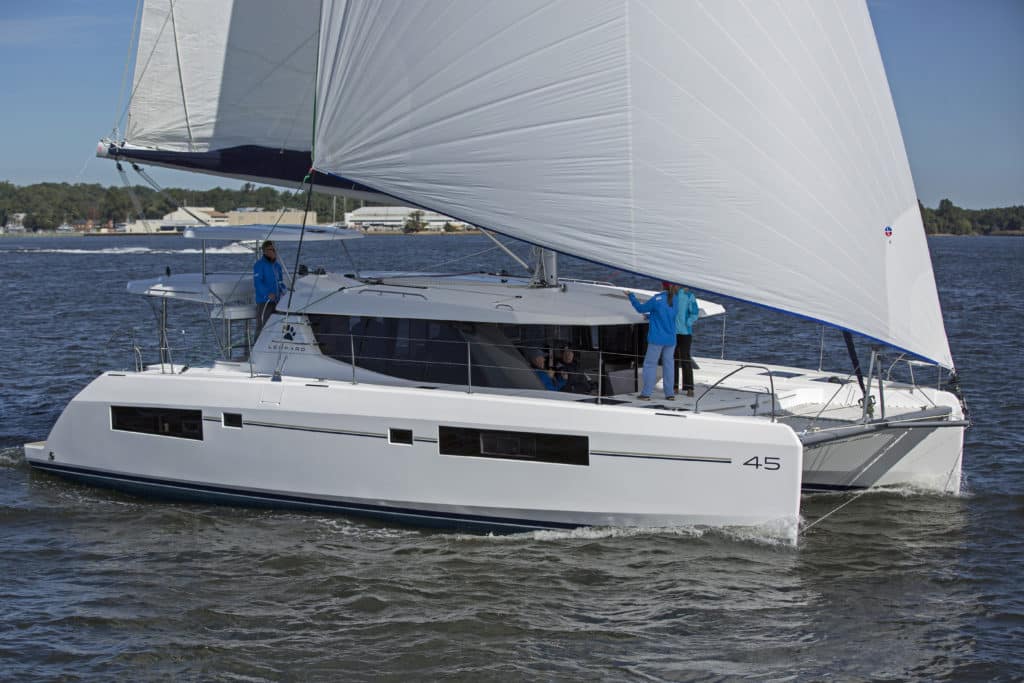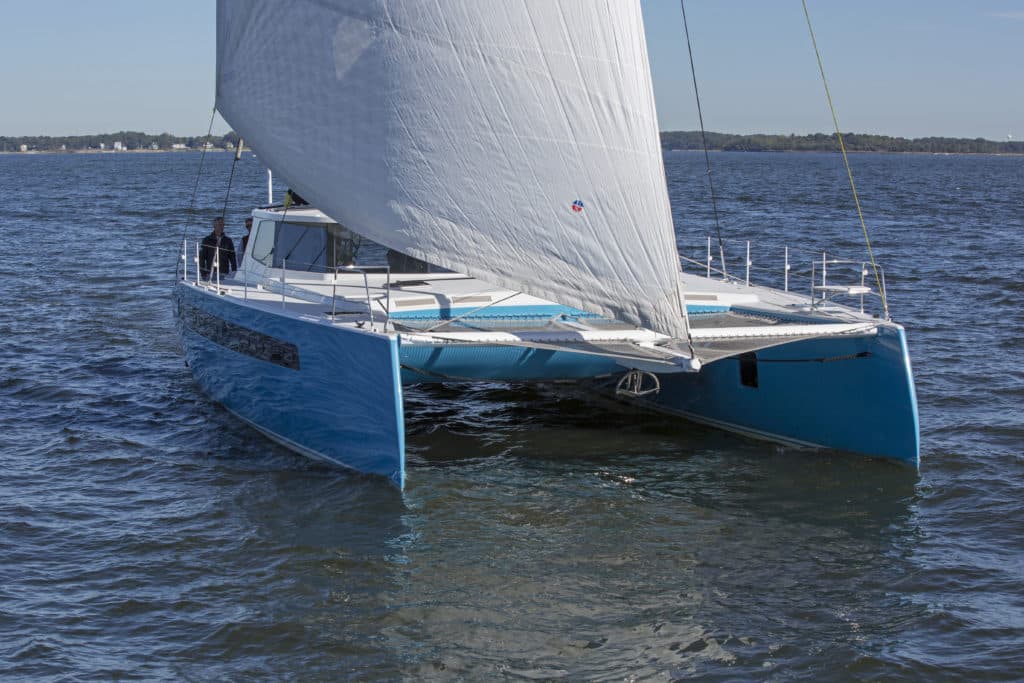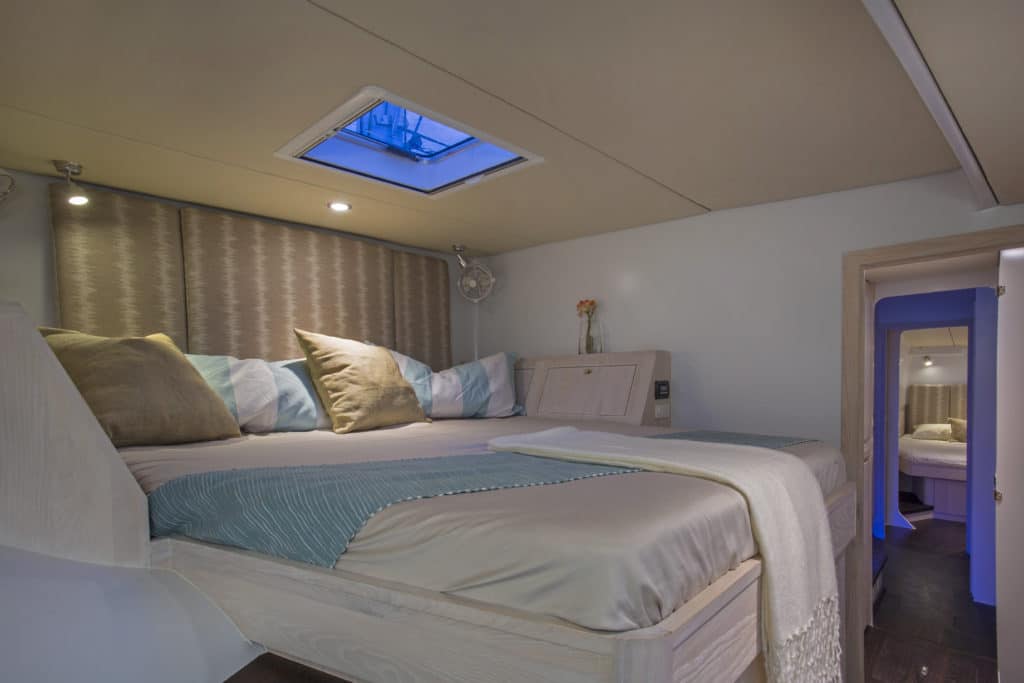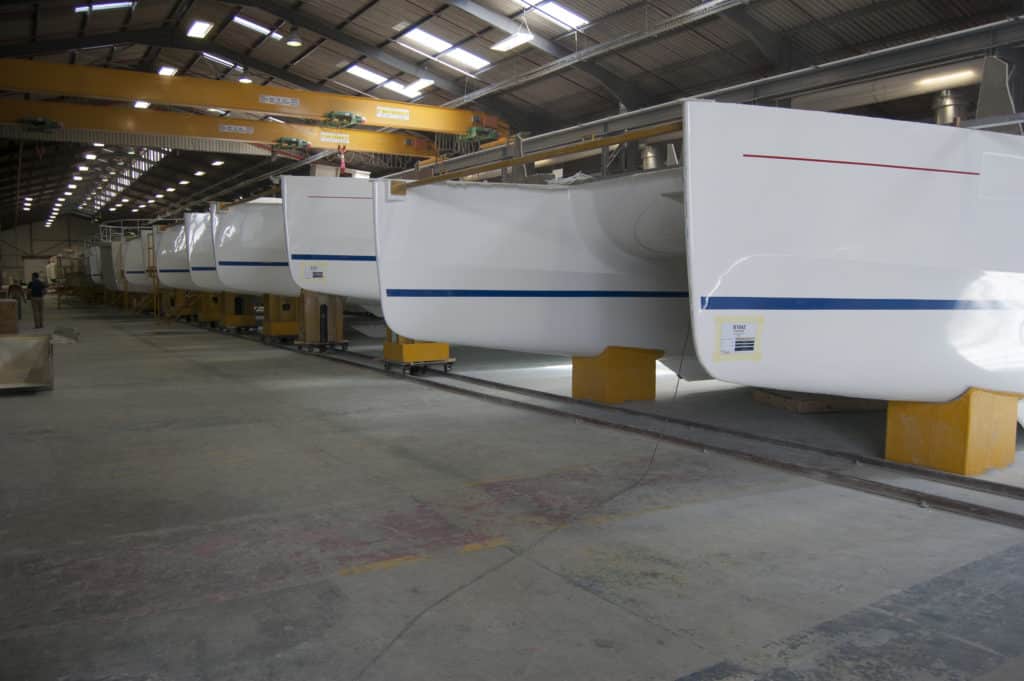
What It’s Not
A crucial step in defining anything is to clarify what it’s not. We asked each cat creator what they knew their boat was not going to do or include.
Dick Vermeulen (Maine Cat 38): This boat is not going to have to sleep 12 people. It has to sleep five people. And it doesn’t need two heads. It needs one head. We can put a Porta Potti over in the other hull so they’ve got privacy over there. But they don’t need two showers. They don’t need two holding tanks. They don’t need all that garbage. You can’t have the genset. Because the design of the boat is so open, if you can sleep on the bridgedeck, if you can sleep on the trampolines, if you can sleep in a hammock hung underneath the hardtop, maybe we don’t need air conditioning. Maybe we don’t need to be in a cabin with a door on it, with no ventilation. The design of the interior of this boat says, well, I’m just not going to do AC, so you can get rid of a lot of junk. Simple: That’s the design criteria.
Phil Berman (Balance 526): I wouldn’t ever recommend this boat for bareboat charter. It’s just too performance oriented. This is all E-glass with carbon reinforcements and epoxy resins. Composite bulkheads, liberal use of carbon all over the place — this is a much more sophisticated boat than your typical charter boat.
Fred Signat (Lagoon 42): We didn’t choose daggerboards, because that’s really not in the Lagoon philosophy. Comfort means volume in the cabins. The galley today is really the key point. That’s why we didn’t use the daggerboards. We wanted to keep the volume inside.
Franck Bauguil (Leopard 45): There’s a limit to how far you can push volume. Lagoons have gigantic beds. If we want a gigantic bed and a big cockpit, it’s not going to happen. This is where we know what we have. For us it’s crystal clear: We’re going to favor the common areas, where you spend most of your time. We’re going to have the biggest cockpit in the business, but we’re not going to offer a huge bed, because you can’t have both.
I’m always trying to understand with numbers how our customers are utilizing this boat. For example, we found out that on our Moorings 4800 four-cabin boat, only half the time do we have eight people on it. So I’m asking: How many people are on the boat? Where do they sleep? I have some data, but I’m missing some, because if I have a six-pass (six-passenger charter), it could be three couples, or it could be a big family with teenagers and kids. And teenagers and kids are not going to use cabins in the same way. So now we’re drilling further, with crew lists and the ages of our customers. That’s going to be for our next project to figure out the number of cabins and configurations of cabins.

Comfort and Performance
Skinny catamaran hulls are uncommonly sensitive to the weight that goes into the boat, and too much wetted surface profoundly hinders a cat’s boat speed. Does that mean comfort and performance are a zero-sum choice? We asked each creator how they work through this puzzle.
Franck Bauguil (Leopard 45): We try to do a boat that is a compromise between space and performance. Clearly, we try to offer the comfort people are looking for on cats, but without killing the performance. We keep the hulls very narrow (below the waterline). The volume is above the waterline with the step (chine).
Phil Berman (Balance 526): I met naval architect Anton du Toit, and I liked the way he did his hulls. I liked his general philosophy of hulls that don’t have any protrusions or chines. These hulls, if you look at them, there’s no funny stuff coming out of them. There’s no bumps. There’s no trickery. There’s just pure-form hulls. And that was really important to me, hydrodynamically. All these little tricks that they do to make the boat feel bigger down below, all that does is create hydrodynamic disturbance in the boat. You want the boat to be just a straight hull like a Tornado catamaran. So I asked Anton, if we want this boat to tool along without difficulty at 10 to 12 knots, what’s the hull-fineness ratio have to be? How wide can we go? How wide can we make the berths in the aft end of the boat — without bumping it out or creating chines to make the hulls wider than they should be?
It became clear that the aft berth to port would have to be slightly narrower and smaller than the berths athwartships because, if we widened the hull just another 6 inches back there, we wouldn’t have achieved the hull-fineness ratio required to do the speeds we wanted to do. I kind of knew from the beginning that we would have our master berth athwartships over the bridge because that’s what Peter Johnstone did in the Gunboats. I think that’s just what you have to do if you really want to have beds from which you can get off on either side — and really good headroom.

I wanted the bridgedeck clearance to be around 3 feet off the water but loaded. When this boat’s empty, it’s probably 3 feet 3 inches. To go any higher, you really start getting into too much windage on the sides of the hulls, and you start adding weight to the boat. And that windage hurts you upwind significantly. It really blows you back. It also makes it harder to dock the boat, because you’re getting blown around. We had like 2-foot-7-inch clearance on the Dolphin 460 that we did in Brazil, and that boat was great. In some really, really bad conditions you’re going to get an occasional slap or pound. You’re not going to get away from that. But remember, the sharper the bows and the smaller the bow wave, the less clearance you need. The higher performance the boat, the less bridgedeck clearance you need. Because the bows are so sharp, it’s not creating a bow wave. And a lot of the slapping occurs from the big waves when the boat is rocking. The bow waves meet right about the saloon door, and you’ll hear it: boom, boom, boom, boom. But all things being equal, I know for a 50-footer, 3 feet is the balanced choice.
Fred Signat (Lagoon 42): We learn from the past. The Lagoon 420 has a very long bridgedeck, with a very small net. The comfort was great because it had lots of volume. But clearly the boat was sailing like a dog. For the Lagoon 42, we reduced the bridgedeck ratio (LOA-to-bridgedeck length) to 1.52-to-1.
Dick Vermeulen (Maine Cat 38): I made a decision very early on that this boat was going to have a chine, or what I’d call a knuckle. It was going to have a really skinny waterline and a really nice knuckle, and then we’d belly it out because I thought it looked really cool. It’s about 12 inches off the waterline. It is probably the best thing we’ve ever drawn. It’s unbelievable, because what it does underneath the boat in the bridgedeck area is it curves all that water. When you’re in an 8-foot wave, obviously, game’s over. But if you’re in the normal 3 to 4 feet and you’re cutting through a wave and doing 12 or 13 knots, you don’t hear anything. The boat’s silent. And that’s because it’s not allowing that water that would normally be jumping up and hitting the underside of the bridgedeck. It turns it right away. It also makes spray out of everything down there, so you are perhaps inducing some drag. But you’re also making the boat really, really quiet.

From Abstract Design to Physical Structure
It’s one thing to use high-tech, three-dimensional computer-aided design software to render boats and their components, but there’s no substitute for creating full-scale structures in space to test those designs. We asked each cat creator what they learn in the building stage that the designs couldn’t entirely reveal.
Phil Berman (Balance 526): In the design drawings, we generally marked out the area for our helm station. And we did tons and tons of drawings for sight lines and stuff. You want to be able to sit and see out over the water at all times, and always be in the light. We knew when we got to that point, it had to be mocked up, so I visited the factory in South Africa. It was really important for me to sit around the chairs and see the sight lines. And headroom is important. Frankly, I think the only real mistake you see in the Balance 45 (a Roger Hill design built in China) is that the boat didn’t have 6-foot-6-inch headroom. This boat’s headroom is 6-foot-9.
Fred Signat (Lagoon 42): We work with VPLP Design for naval architects and Nauta Yachts Design for the interiors. They know that we have some industrial points we have to follow. For example, we have some wood rail shapes that we want to reuse, and we have some composite constraints — the way you design it and design the mold — that we cannot avoid. So that’s an impact on some shapes. For every model, we have a project manager in-house who’s the link between the naval architects and our designers. Once we pass the files to the designers and say go, they work in parallel. They’re talking to each other. Even when the architects are still working on the hull shape, we can start plumbing and electricity very early. Once we have the final hull shape, it’s quite easy to modify the plumbing to make sure it follows the hull.
We still do some full-scale mock-ups to evaluate the volume of the galley. Or to make sure we have enough room in the heads. Even though we have lots of experience, it’s very easy to make mistakes. Most of the time it’s in plywood, just to have an idea of volume. But we don’t go into details of finishing.
For the Lagoon 42 and the last several projects, we produced hull number one and hull number two. Number one was at the Dusseldorf show; hull two was at the Miami show. And then we stopped the line. We sailed the boats, tested the boats. Then after we do the reverse engineering and feedback, the idea is to really start the production line. We start to deliver the boats three to five months after that.

Dick Vermeulen (Maine Cat 38): For this project, we came across thermoforming. Hodgdon Yacht Services had done it in one of its designs. Lyman-Morse had done it. We found a company in Rhode Island that did these infrared ovens, and JP Mouligné at Gurit showed us some stuff this thing could do. We get Corecell sheets up to 165 degrees, and it’s infrared, so it’s heated completely through the material. Then you place the Corecell in the mold, and you press it down. You let it cool for about a minute and a half, take your hands off, and it doesn’t change shape. The core starts as flat sheets, not 1-inch cubes with scrim like Divinycell, so there are no kerfs to fill with resin. When we built the first 38 hull — no deck on it yet, but three bulkheads in it, 6 feet wide at the beam, probably another 6 feet in depth — it weighed 426 pounds. I could lift the thing out of the cradles. It blew us away. It was the biggest revelation we’ve ever had in construction. We infuse all the way through the entire boat with vinylester resins. It takes us a hell of a lot longer to build boats, but it’s just bomber. I just saved 50 pounds. I was ecstatic. If I can make it strong and I can make it light, I’ve got the world by the tail.
Franck Bauguil (Leopard 45): Mock-ups are fantastic. We don’t involve a big design committee by that stage. Just John Robertson and me. It’s a very family-type organization. It’s a bit old-school, but you know how particular we are about helm stations. We make sure everything flows: distribution, movement. That’s not a coincidence. Yeah, CAD is great, and virtual tours and 3D. You can probably do 90 percent on the CAD. But I’ll tell you, on the mock-up, we change stuff. We make sure all the maneuvers are going to flow, all the sheets and halyards, the foot switch. I have to know that I can singlehand this boat. The helm station is crucial. Everything is mocked up, down to: Can I take a shower without getting everything wet? If I open that electrical panel, how long is that going to take? Can I reach the bottom of the fridge? Can I access my steering? I don’t even write these things in the design brief, because it’s understood. We have to turn the boats around quickly (in charter operation). And if anything breaks, we have to replace it right away.
Vive la Difference!
There you have it. One builder unabashedly offers the greatest volume in a given length. One builder seeks a compromise in trading private space for public areas to gather in. One builder willingly trades away the gadgets of home-style comforts for lightness and speed. And one builder aims to balance the difference. Every one of those design criteria we cited at the top — comfort, performance, ease-of-use, good ergonomic flow — is a worthy goal for cat creators to strive for. In the meantime, we can thank Neptune for the risk-takers who wake up every day and mix these ingredients to their own tastes and share the results with all of us — especially those lucky sailors who get to take them sailing.
Tim Murphy is a Cruising World editor-at-large and a longtime Boat of the Year judge.








